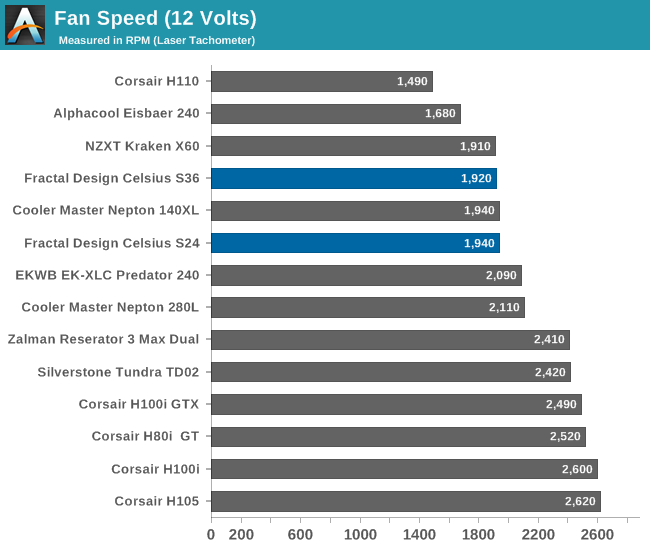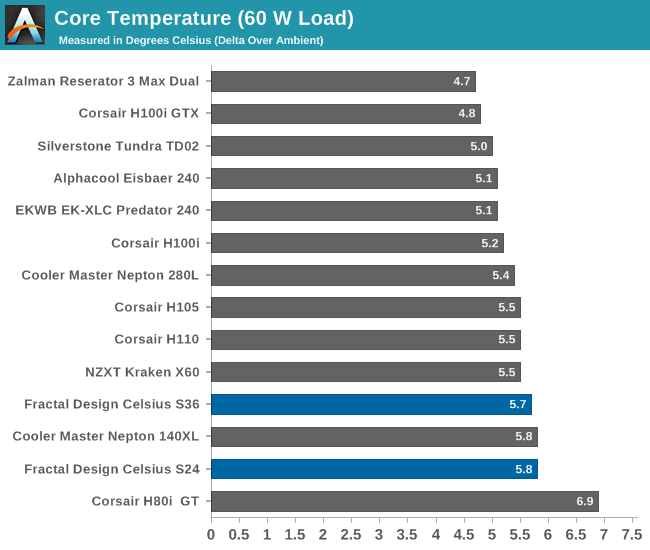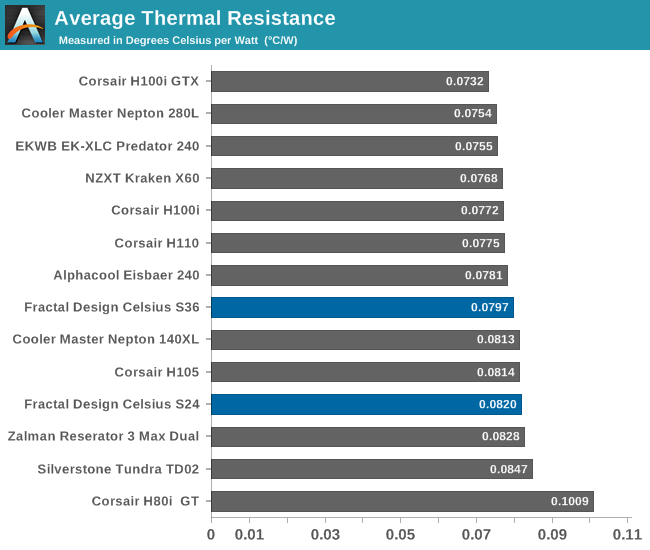The Fractal Design Celsius S24 & S36 AIO Coolers Review
by E. Fylladitakis on June 2, 2017 8:00 AM ESTTesting Results, Maximum Fan Speed
Starting things off, let's take a look at cooler performance with the fans at their full, 12 V fan speed.


Our concurrent testing of the two Celsius variants gave us some very interesting results. With their fans running at their maximum rated speeds, the performance of the Celsius S24 is not record-breaking, yet it definitely is competitive, especially when taking the lower noise figures into account. The average thermal resistance of the Celsius S24 is 0.082 °C/W, which is slightly higher than that of most other dual 120 mm fan coolers, but our sound pressure meter was also recording only 38.7 dB(A) at the time of the test, which is the lowest figure that we have recorded up to this date from any comparative AIO cooler.

| Core Temperature, Constant Thermal Load (Max Fan Speed) |
Comparing the performance of the Celsius S24 to its larger S36 is not as straightforward as most people would assume. Despite its significantly greater mass, the S36 delivers virtually the same performance at lower load levels. As the load increases, the performance gap between the two coolers widens slightly, but only at very high power loads does the S36 display a true performance advantage. Ultimately, the average thermal resistance of the Celsius S36 is slightly better, at 0.0797 °C/W, but only because of its ability to handle very high thermal loads more efficiently. Meanwhile, the noise level rises to 40.6 dB(A), diminishing the thermal performance gains even further.











31 Comments
View All Comments
ratbert1 - Friday, June 2, 2017 - link
Please add a water cooled graphics card to the loop and see if it can cool both. That seems to be what these coolers are about.makerofthegames - Friday, June 2, 2017 - link
I was looking at these for a new build, because I might upgrade it to a custom cooling loop after a few years. An S36 would be a bit overkill for just a single consumer-grade CPU, but it would save the cost of a radiator if I upgrade. I'd still need a reservoir, GPU cooling block, and probably a pump, but it would at least save on the radiator.I might base my choice off what GPU I end up getting, since a long one would collide with the S36 in the case I'm using. And a radiator isn't that expensive, anyways.
nekronimus - Wednesday, October 18, 2017 - link
You could mount the S36 (pump) on the most popluar GPU using the kraken G12 GPU mounting kit. You could then buy a seperate CPU cooling block (50$) and reservoir and you're done. It's lot cheaper than mounting the S36 on the CPU and buying a seperate GPU cooler (starting 120$). Graphic cards are replaced more often than CPU's, so in the long run the first setup would also be way more cheaper, just by a new mounting kit and you're good to go.LawRecords - Saturday, June 3, 2017 - link
I'm building a new machine with a Phantek Evolv ATX case and the Celcius S24 cooler for the CPU. My GFX card is an air cooled Asus STRIX 1080 Ti. What is the best location of the radiator in that case, given that setup? I read somewhere that having the radiator at the top will be sub-optimal due to heat rising from the GFX card. Not sure if that's true. But regardless, where do you think will be best to minimize noise (want it as quiet as possible) for decent cooling?maximumGPU - Sunday, June 4, 2017 - link
you can always put it up top fans in pull rather than push. That way you won't take heat for your gpu, but more importantly (for me at least) you'd have positive air pressure in your case to keep dust out.To be honest though front or up won't make much difference in either temps (1-2 deg difference max) or noise, just go with whatever looks best to you and is easiest to install.
nekronimus - Wednesday, October 18, 2017 - link
Depends on how hot your 1080 Ti is running now. GPU's start throttling way faster than CPU's. I would avoid putting it in the front of your case, adding hot air to your GPU. Your CPU might run a degree or two colder but your GPU would have to endure an additional 3-5 degrees (depending on how well you airflow is through your case) whilst having less room before it starts throttling...sultan_khan - Sunday, June 4, 2017 - link
Please write on the following topicsAmazing Animated Gif Wallpapers-https://www.yourtechnocrat.com/gif-animated-wallpa...
PS3 Emulator android-https://www.yourtechnocrat.com/ps3-emulator-androi...
Linux OS For Android-https://www.yourtechnocrat.com/kali-linux-for-andr...
kushakizz - Thursday, June 8, 2017 - link
does the extra tube come with it for your video card...and if so all i have to do is buy a vc block riight and connect? or is there more to itJohnLinc - Tuesday, June 13, 2017 - link
thisistotesthedelayforwebTechEnthusiast - Friday, June 23, 2017 - link
Can we see real life scenarios now? I mean you've tested them using environments that nobody will use at home. Which is understandable if you want to achieve the maximum cooling capacity. But would like to see more normal examples on particular pc cases. I can also go to the north pole and see what temps i get there you know